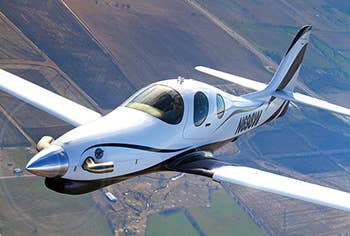
Lancair continues to make improvements to its single-engine Evolution turboprop, modifying the engine inlet and adding a BRS parachute. The modifications will be included as standard equipment in the experimental airplane kit starting with Serial Number 70, the build of which will begin at the Lancair factory in the end of August, Lancair's sales and marketing director Doug Meyer said in a press conference at EAA AirVenture in Oshkosh, Wisconsin.
The price for the BRS adds $60,000 to the kit for a total price, minus firewall forward, of $630,000. The cost for the complete airplane, using a professional builder, is approximately $1.45 million and includes Garmin's G900X avionics suite integrated with the GFC 700 autopilot, electronic standby instruments and more, Meyer said. While the BRS is included in the standard kit, customers can remove the added cost of the parachute.
The BRS has been purpose-built for the Evolution to handle the size, weight and speed of the turboprop, using materials similar to those used in the Cirrus Airframe Parachute System (CAPS) but with some "exotic materials," said BRS founder and director Boris Popov. The required repacking cycle will be similar to that of the Cirrus, which is every 10 years, Popov said. The BRS system adds about 80 lbs to the empty weight of the airplane.
Meyer said the modification of the engine inlet recovered about 100 lbs of lost torque, allowing the airplane to achieve demonstrated true airspeeds in excess of 300 knots. The redesign has also helped with oil cooling and, while the engine inlet is not heated, the new design has improved its ice resistance. Read more about the Lancair Evolution here.
With the increasing market saturation of BRS parachutes in general aviation airplanes, BRS now claims 324 lives have been saved as a result of pilots pulling the parachute.
Get exclusive online content like this delivered straight to your inbox by signing up for our free enewsletter.

Sign-up for newsletters & special offers!
Get the latest FLYING stories & special offers delivered directly to your inbox






